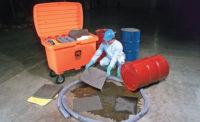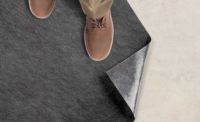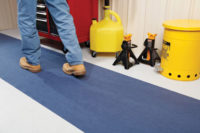A major U.S. city has miles of colonial clay brick sidewalks that were installed generations ago. Over the years, the sidewalks have become very uneven creating trip hazards for everyone walking on them. The problem is further exasperated by shade trees planted every 20 to 30 feet along the sidewalk. As the trees have grown their branches keep the sidewalks shaded, providing a reprieve from the hot sun in the summer months. But their roots have pushed the bricks up, creating uneven walking surfaces and slippery wet areas.
Instead of repairing the uneven bricks and trimming the tree branches, the city chose to hang permanent “Caution: Watch Your Step” signs around the trunk of each tree. The signs have been in place for more than five years now, but nothing has been done to repair or replace the sidewalks. While these signs show that the city is aware of the problem, they do not effectively eliminate the hazard.
Signs aren’t enough
When employees suffer slip and fall injuries near a building entrance or in a production area, too many facilities simply pay the workers’ compensation claims, post “wet floor” signs and perhaps place a mop and bucket in the area —the industrial equivalent to the above scenario. Identifying floor safety hazards with signs isn’t enough. Establishing a floor safety plan that identifies hazards and details the steps that will be taken to eliminate those known hazards will be much more effective in preventing slip, trip and fall injuries.
Floor safety isn’t just a job for the maintenance or cleaning crews. Because floor hazards can affect everyone in the facility, employees should be trained to recognize hazards and know their roles in preventing same-level slip, trip and fall injuries.
Walking surface hazards
Even before employees enter the building they can be exposed to walking surface hazards. Potholes in parking lots, cracked pavement, uneven sidewalks and loose dirt are just a few common outdoor walking surface hazards. Indoors, problems such as frayed carpets, cracked tile, loose floor boards and buckled entrance matting can all create hazards.
Walking surfaces that are wet, snow covered, or icy — or surfaces that have some type of loose, dry contaminant such as dirt, sawdust, metal shavings or sand on them — can contribute to slip and fall injuries. In fact, problems with the walking surface are the main cause of more than half of all slip and fall injuries, according to the National Floor Safety Institute.
Production area hazards
Overspray, hydraulic line leaks, drips from dip tanks, water from wash-downs and dust from grinding operations are all examples of things that can make floors in production areas slippery. Boxes, tools and other items that are left in walkways are an additional hazard.
Although OSHA requires workplace floors to be kept clean and dry, even the agency acknowledges that this is not always possible. Using squeegees, absorbents, or perforated floor mats can help minimize wet or oily floor hazards. Sweeping or vacuuming dust and other particulates regularly prevents them from building up.
Providing slip-resistant footwear for employees who work in areas of the facility that have persistently slippery floors can also be part of the plan, but they should not be the only solution to hazards in these areas.
Entrance hazards
Some facilities take great pride in their building’s lobbies. They install highly polished marble or granite flooring and bright lights that intensify the shininess of those floors. Lobbies can make a great first impression, but the combination of a smooth floor and the glare created by bright lighting can be quite troublesome when rain or snow is tracked into the building.
Even more humble entrances with surfaces such as smooth concrete or vinyl can be slippery when they are wet. Outdoor awnings or canopies can help to minimize the amount of rain or snow that is tracked into the building. Absorbent, adhesive backed floor mats used inside doorways help dry feet without the common problems created by traditional entrance matting. Carpet tiles, floor squeegees and floor-level fans are also solutions that can help keep floors dry.
Transition area hazards
Transition areas are where the walking surface changes. The more drastic the difference between the two surfaces is, the greater the likelihood of injuries. An example of a transition area is going from a carpeted office into a production area with a smooth, sealed concrete floor.
In some instances, matting or special surface preparations can be used on the floors to ease transitions. Ensuring that transition areas are well lit is another way to make these transitions easier to see and minimize the chance of injuries.
Fluid transfer areas
Fluid dispensing stations and liquid waste collection areas are two areas where leaks and drips are likely to cause slippery walking surfaces. In addition to the puddles that may be left when someone overfills a container, spilled liquids often get tracked from these areas into walkways, creating slip hazards that can extend several yards from the dispensing or collection point.
Stocking absorbents or squeegees in these areas and teaching everyone to clean up small, incidental spills keeps these areas cleaner and safer.
Lighting hazards
Some slip, trip and fall injuries are caused by inattention – meaning that the person didn’t see the hazard because they were distracted. Others, however, are caused by insufficient lighting: the person couldn’t see the hazard because it was hidden.
Footwear hazards
Slip-resistant shoes have already been mentioned as an effective part of a floor safety program. However, like other forms of personal protective equipment; if they are not replaced when the soles become worn or smooth, they aren’t providing adequate protection.
Weather-related hazards
It’s probably not a surprise that slips and falls increase in the winter months when walking surfaces become covered with ice or snow. But fallen leaves in the autumn and left-over anti-slip products that aren’t swept up in the spring can also cause injuries.
Having a year-round plan for keeping parking lots, sidewalks and other outdoor common areas clean and dry can take some effort, especially if some of the work is contracted through service providers.
Bottom line: Identifying floor safety problems, proactively correcting them and incorporating good housekeeping measures helps prevent workplace injuries.



